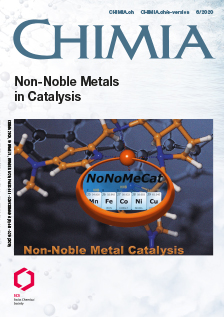Catalytic Oxidation of Primary C–H Bonds in Alkanes with Bioinspired Catalysts
DOI:
https://doi.org/10.2533/chimia.2020.470PMID:
32560752Keywords:
Alkane oxidation, Hydrogen peroxide, Iron, Manganese, Primary c–h bondsAbstract
Catalytic oxidation of primary C–H bonds of alkanes with a series of iron and manganese catalysts is investigated. Products resulting from oxidation of methylenic sites are observed when hexane (S1) is used as model substrate, while corresponding primary C–H bonds remain unreactive. However, by using 2,2,3,3-tetramethylbutane (S2) as model substrate, which only contains primary alkyl C–H bonds, oxidation takes place catalytically using a combination of hydrogen peroxide, a manganese catalyst and acetic acid as co-catalyst, albeit with modest yields (up to 4.4 TON). Complexes bearing tetradentate aminopyridine ligands provide the best yields, while a related pentadentate ligand provides smaller product yields. The chemoselectivity of the reaction is solvent dependent. Carboxylic acid 2b is observed as major product when the reaction takes place in acetonitrile, because of the facile overoxidation of the first formed alcohol product 2a. Instead the corresponding primary alcohol 2a becomes dominant in reactions performed in 2,2,2-trifluoroethanol (TFE). Polarity reversal of the hydroxyl moiety arising from the strong hydrogen bond donor ability of the latter solvent accounts for the unusual product chemoselectivity of the reaction. The significance of the current results in the context of light alkane oxidation is discussed.Downloads
Published
2020-06-24
Issue
Section
Scientific Articles
License
Copyright (c) 2020 Valeria Dantignana, Anna Company, Miquel Costas

This work is licensed under a Creative Commons Attribution-NonCommercial 4.0 International License.
How to Cite
[1]
Chimia 2020, 74, 470, DOI: 10.2533/chimia.2020.470.







